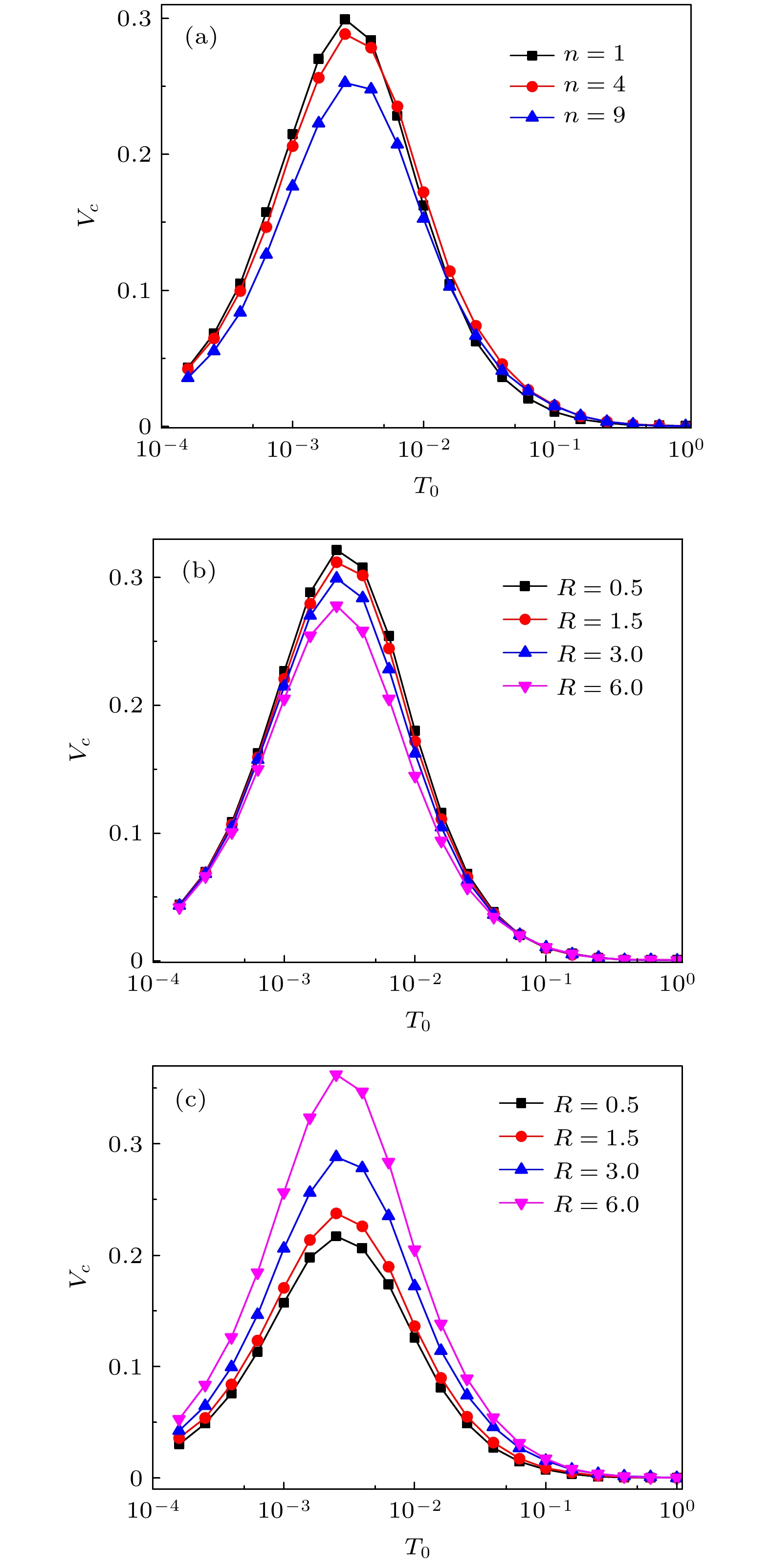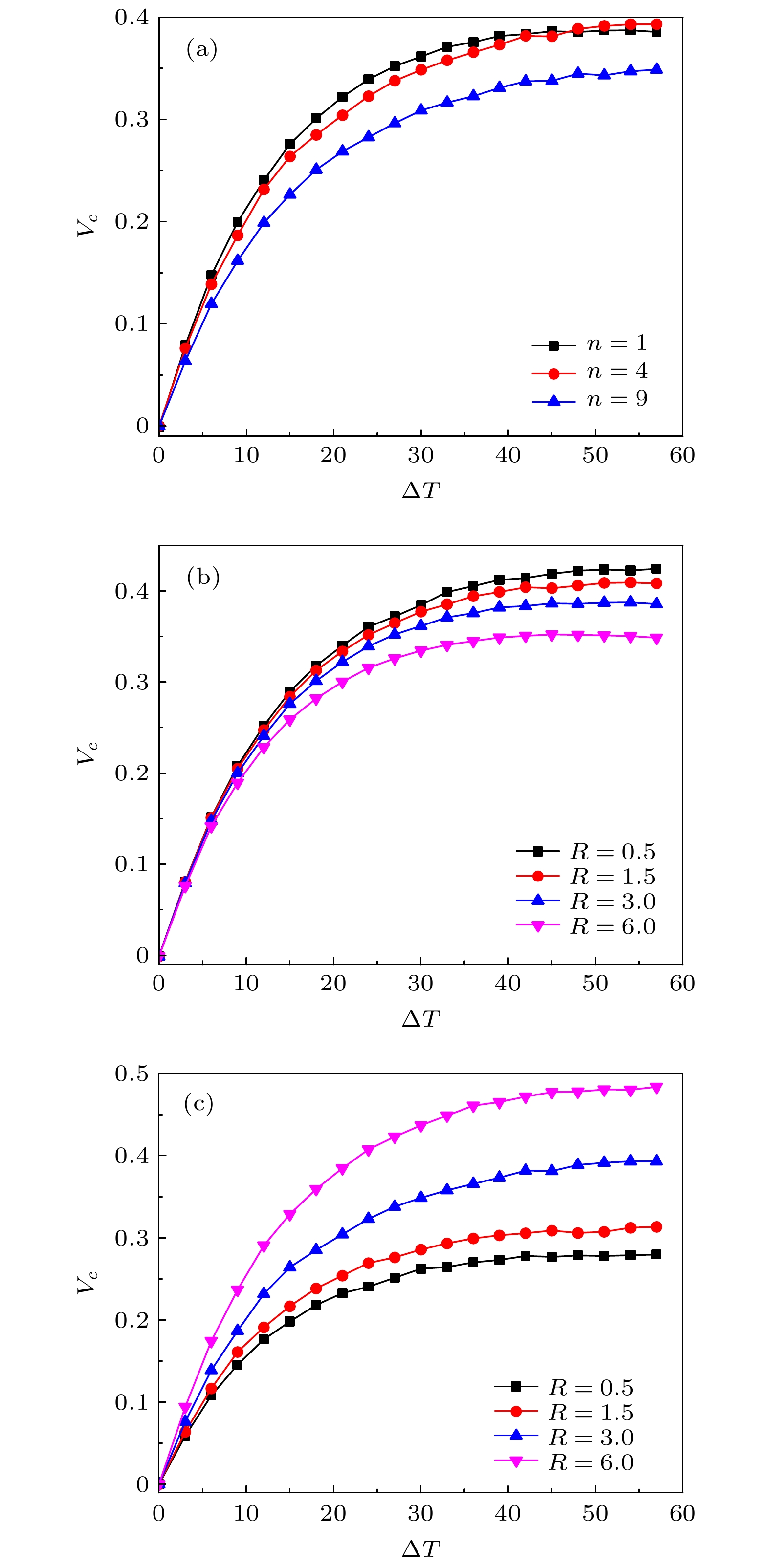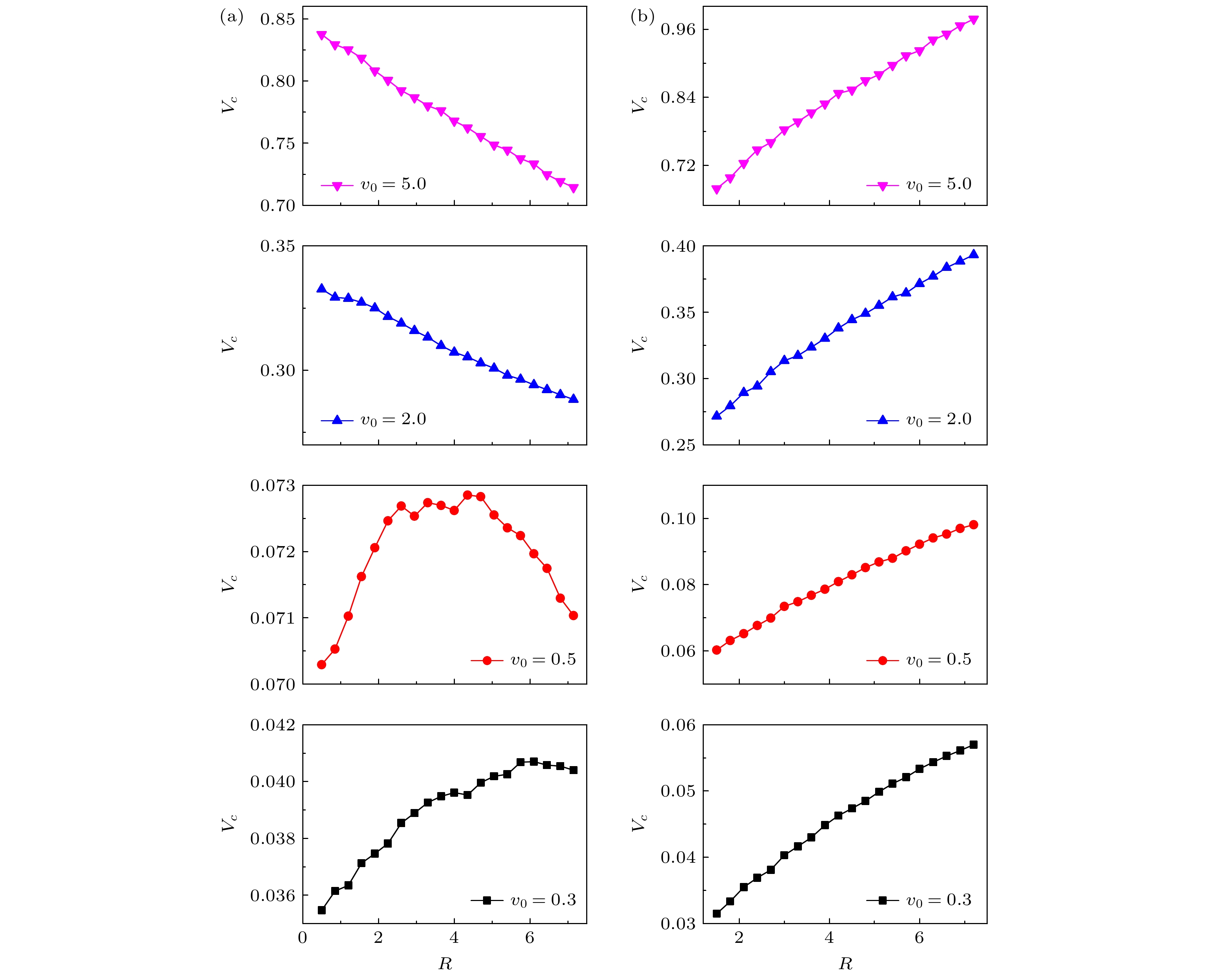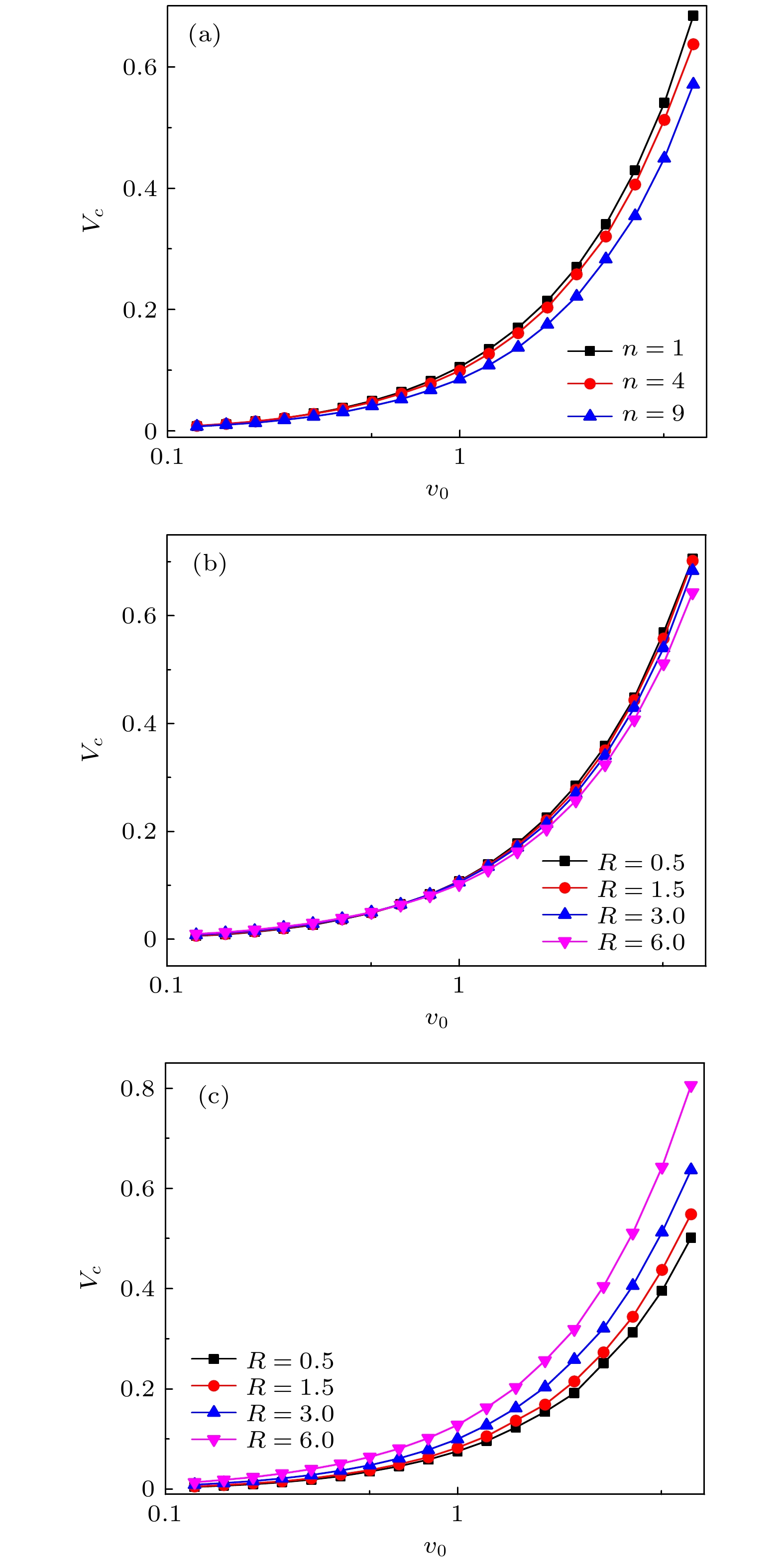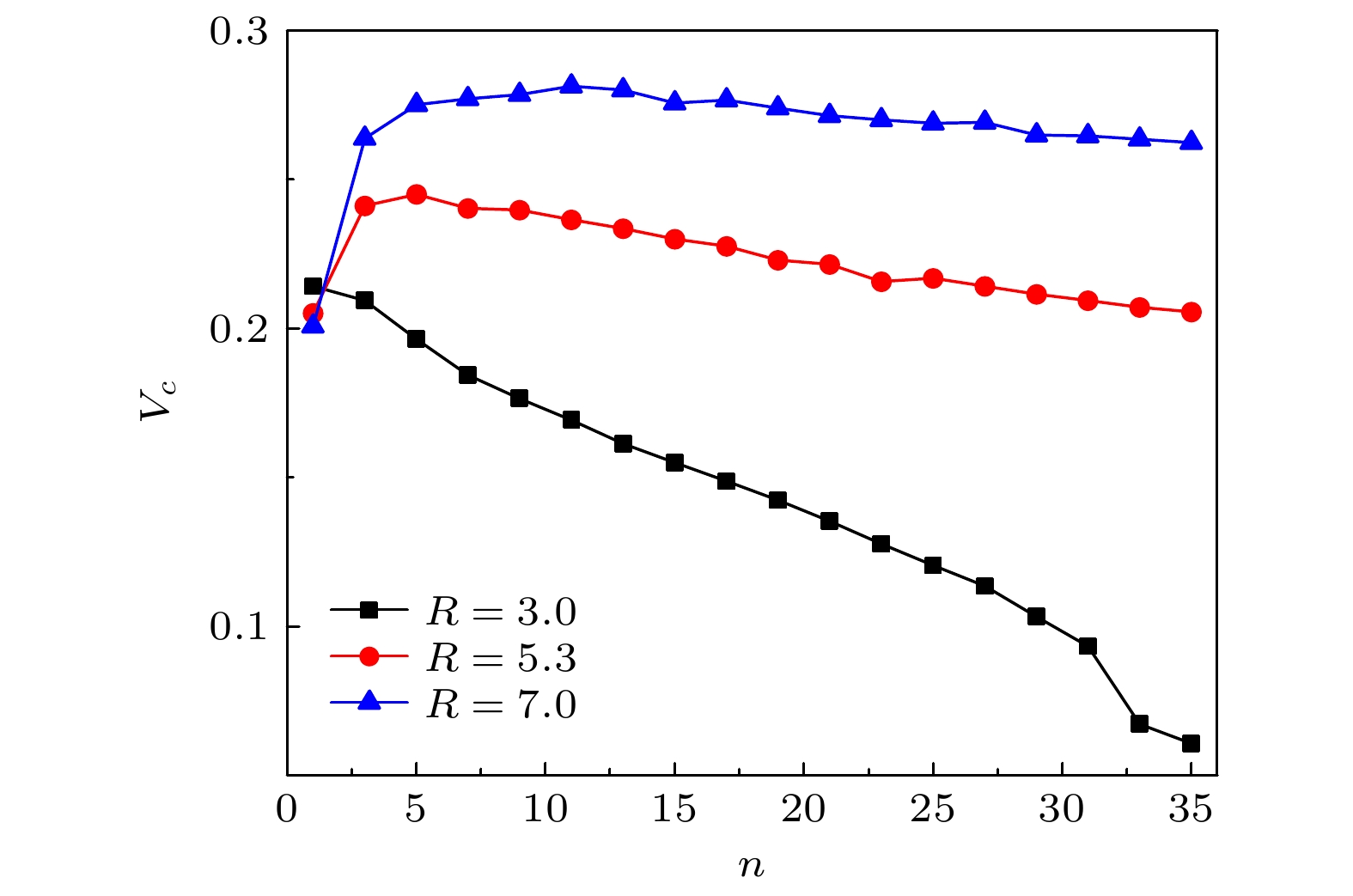-
在温差条件下, 由于二维周期通道的横向温度差引发的上下不对称和活性粒子的手征性质使得活性粒子在纵向发生定向运动, 继而驱动包裹粒子的封闭圆环定向输运. 圆环的运动方向由粒子的手征性决定. 研究表明, 圆环的运动速度是活性粒子的角速度、下壁温度及温度差的峰值函数. 圆环包含一个手征活性粒子与包含多个手征活性粒子的定向运动行为具有较大差异. 特别是, 圆环半径对两种情况下圆环的运动行为差异影响较大. 当封闭圆环只包含一个粒子且粒子做圆周运动的轨迹半径较大(小)时, 粒子与圆环的相互作用对圆环定向运动起促进(抑制)作用, 圆环速度随圆环半径增大而减小(增大); 当封闭圆环包含多个粒子时, 粒子间的相互作用对圆环定向运动起抑制作用, 圆环半径越大, 粒子间相互作用越弱, 圆环速度越大. 本文的研究结果为在微尺度上活性粒子流的操控提供了新的可能性.Active matter is a new and challenging field of physics. Chiral active particle experiences a constant torque and performs circular motion due to the self-propulsion force not aligning with the propulsion direction. Recently, most of studies of the active particle systems focused on constant temperature, but did not take into consideration the constraints by the barriers. In our work, the rectification of a ring containing chiral active particles with transversal temperature difference is numerically investigated in a two-dimensional periodic channel. It is found that the ring powered by chiral active particles can be rectified by the transversal temperature difference and the direction of the transport is determined by the chirality of active particles. The average velocity is a peaked function of angular velocity, the temperature of the lower wall or temperature difference. The transport behaviors of the ring containing one chiral active particle is qualitatively different from those of the ring containing several particles. Especially, the ring radius can strongly affect the transport behaviors. For the ring containing one chiral active particle, the interaction between the particle and the ring facilitates the rectification of the ring when the circular trajectory radius of the chiral particle is large. The average velocity decreases with the increase of the ring radius because the propelling force to the ring by the particle is small. When the circular trajectory radius is small, the interaction between the particle and the ring suppresses the transport. The speed increases as the ring radius increases because the directional transport comes from the difference in temperature between the upper wall and the lower wall. For the ring containing several particles, the interaction between particles reduces the rectification of the ring. The average velocity increases with the increase of the ring radius due to the interaction between particles decreasing. Remarkably, the velocity of the ring decreases as the particle number increases when the ring radius is small, but is a peaked function when the ring radius is not small. Our results offer new possibilities for manipulating an active particle flow on a microscale, and can be applied practically to propelling carriers and motors by a bath of bacteria or artificial microswimmers, such as hybrid micro-device engineering, drug delivery, micro-fluidics, and lab-on-chip technology.
-
Keywords:
- chiral active particles /
- confined ring /
- temperature difference /
- transport
[1] Bechinger C, Di Leonardo R, Löwen H, Reichhardt C, Volpe G 2016 Rev. Mod. Phys. 88 045006
 Google Scholar
Google Scholar
[2] Liebchen B, Levis D 2017 Phys. Rev. Lett. 119 058002
 Google Scholar
Google Scholar
[3] Levis D, Liebchen B 2018 J. Phys.: Condens. Matter 30 084001
 Google Scholar
Google Scholar
[4] Reichhardt C J O, Reichhardt C 2017 Nat. Phys. 13 10
 Google Scholar
Google Scholar
[5] Potiguar F Q, Farias G A, Ferreira W P 2014 Phys. Rev. E 90 012307
 Google Scholar
Google Scholar
[6] Lauga E, DiLuzio W R, Whitesides G M, Stone H A 2006 Biophys. J. 90 400
 Google Scholar
Google Scholar
[7] Loose M, Mitchison T J 2014 Nat. Cell Biol. 16 38
 Google Scholar
Google Scholar
[8] Nguyen N H P, Klotsa D, Engel M, Glotzer S C 2014 Phys. Rev. Lett. 112 075701
 Google Scholar
Google Scholar
[9] Scholz C, Engel M, Pöschel T 2018 Nat. Commun. 9 931
 Google Scholar
Google Scholar
[10] Scholz C, Jahanshahi S, Ldov A, Löwen H 2018 Nat. Commun. 9 5156
 Google Scholar
Google Scholar
[11] Lei Q, Ciamarra M P, Ni R 2019 Sci. Adv. 5 eaau7423
 Google Scholar
Google Scholar
[12] Liao G J, Klapp S H L 2018 Soft Matter 14 7873
 Google Scholar
Google Scholar
[13] Reichhardt C, Reichhardt C J O 2019 J. Chem. Phys. 150 064905
 Google Scholar
Google Scholar
[14] Metselaar L, Doostmohammadi A, Yeomans J M 2019 J. Chem. Phys. 150 064909
 Google Scholar
Google Scholar
[15] Ma F, Wang S, Wu D T, Wu N 2015 Proc. Natl. Acad. Sci. 112 6307
 Google Scholar
Google Scholar
[16] Ventejou B, Chaté H, Montagne R, Shi X 2021 Phys. Rev. Lett. 127 238001
 Google Scholar
Google Scholar
[17] Mijalkov M, Volpe G 2013 Soft Matter 9 6376
 Google Scholar
Google Scholar
[18] Ai B Q, Chen Q 2015 J. Chem. Phys. 143 104113
 Google Scholar
Google Scholar
[19] Ai B Q, He Y F, Zhong W R 2015 Soft Matter 11 3852
 Google Scholar
Google Scholar
[20] Nourhani A, Crespi V H, Lammert P E 2015 Phys. Rev. Lett. 115 118101
 Google Scholar
Google Scholar
[21] Olson Reichhardt C J, Reichhardt C 2017 Annu. Rev. Condens. Matter Phys. 8 51
 Google Scholar
Google Scholar
[22] Liao J J, Huang X Q, Ai B Q 2018 J. Chem. Phys. 148 094902
 Google Scholar
Google Scholar
[23] Li Y, Ghosh P K, Marchesoni F, Li B 2014 Phys. Rev. E 90 062301
 Google Scholar
Google Scholar
[24] Geiseler A, Hänggi P, Marchesoni F, Mulhern C, Savel’ev S 2016 Phys. Rev. E 94 012613
 Google Scholar
Google Scholar
[25] Ghosh P K, Li Y, Marchesoni F, Nori F 2015 Phys. Rev. E 92 012114
 Google Scholar
Google Scholar
[26] Geiseler A, Hänggi P, Marchesoni F 2017 Sci. Rep. 7 41884
 Google Scholar
Google Scholar
[27] Galajda P, Keymer J, Chaikin P, Austin R 2007 J. Bacteriol. 189 8704
 Google Scholar
Google Scholar
[28] McDermott D, Reichhardt C J O, Reichhardt C 2016 Soft Matter 12 8606
 Google Scholar
Google Scholar
[29] Ghosh P K, Misko V R, Marchesoni F, Nori F 2013 Phys. Rev. Lett. 110 268301
 Google Scholar
Google Scholar
[30] Sandor C, Libal A, Reichhardt C, Reichhardt C J O 2017 Phys. Rev. E 95 012607
 Google Scholar
Google Scholar
[31] Reichhardt C, Reichhardt C J O 2018 Phys. Rev. E 97 052613
 Google Scholar
Google Scholar
[32] Reichhardt C, Reichhardt C J O 2017 J. Phys.: Condens. Matter 30 015404
 Google Scholar
Google Scholar
[33] Reichhardt C J O, Reichhardt C 2018 New J. Phys. 20 025002
 Google Scholar
Google Scholar
[34] Schakenraad K, Ravazzano L, Sarkar N, Wondergem J, Giomi 2020 Phys. Rev. E 101 032602
 Google Scholar
Google Scholar
[35] Kaiser A, Popowa K, Wensink H H, Löwen H 2013 Phys. Rev. E 88 022311
 Google Scholar
Google Scholar
[36] Kumar N, Gupta R K, Soni H, Ramaswamy S, Sood A K 2019 Phys. Rev. E 99 032605
 Google Scholar
Google Scholar
[37] Ribeiro H E, Ferreira W P, Potiguar F Q 2020 Phys. Rev. E 101 032126
 Google Scholar
Google Scholar
[38] Borba A D, Domingos J L, Moraes E C B, Potiguar F Q, Ferreira W P 2020 Phys. Rev. E 101 022601
 Google Scholar
Google Scholar
[39] Yang Q, Zhu H, Liu P, Liu R, Shi Q, Chen K, Zheng N, Ye F, Yang M 2021 Phys. Rev. Lett. 126 198001
 Google Scholar
Google Scholar
[40] Yang Q, Fan Q, Shen Z, Xia Y, Tian W, Chen K 2018 J. Chem. Phys. 148 214904
 Google Scholar
Google Scholar
[41] Zhong W R, Xiong J W, Ai B Q 2018 J. Chem. Phys. 149 174906
 Google Scholar
Google Scholar
[42] Zhu W J, Huang X Q, Ai B Q 2018 Chin. Phys. B 27 080504
 Google Scholar
Google Scholar
[43] 仲颖, 施夏清 2020 物理学报 69 080507
 Google Scholar
Google Scholar
Zhong Y, Shi X Q 2020 Acta Phys. Sin. 69 080507
 Google Scholar
Google Scholar
[44] Tian W D, Gu Y, Guo Y K, Chen K 2017 Chin. Phys. B 26 100502
 Google Scholar
Google Scholar
[45] Ai B Q, Li J J, Li Z Q, Xiong J W 2019 J. Chem. Phys 150 184905
 Google Scholar
Google Scholar
[46] Volpe G, Gigan S, Volpe G 2014 Am. J. Phys. 82 659
 Google Scholar
Google Scholar
-
图 1 (a)手征活性粒子驱动圆环运动的模型. 手征活性粒子驱动包裹它们的圆环在二维周期通道中运动, 通道
$ x $ 方向为周期边界,$ y $ 方向为受限边界且满足温差条件. 设置$ y=0 $ 处温度为$ T_0 $ ,$ y=L_y $ 处温度为$T_0+\text{δ} T$ .$ y $ 方向的温度梯度可由方程(1)描述. (b)逆时针旋转粒子(counterclockwise, CCW)漂移方向. 当$ t_1>t_2 $ 时, 粒子往右边运动; 当$ t_1<t_2 $ 时, 粒子往左边运动Fig. 1. (a) Sketch of a ring containing chiral active particles moving in a two-dimensional periodic channel. Periodic boundary conditions are imposed in the x-direction, and hard wall boundaries with temperature difference are imposed in the y-direction. The temperature is set to
$ T_0 $ at$ y=0 $ and$T_0+\text{δ} T$ at$ y=L_y $ . The temperature gradient in the y-direction is described by Eq. (1). (b) Sketch of the drift directions for counterclockwise (CCW) particles. The particles on average move to the right for$ t_1>t_2 $ and the left for$ t_1<t_2 $ 图 2 平均速度
$ V_c $ 随角速度$|\varOmega|$ 的变化 (a)在不同手征活性粒子数$ n $ 下,$ R=3.0 $ 且$ \Delta T=5.0 $ ; (b)在不同圆环半径$ R $ 下,$ n=1 $ 且$ \Delta T=5.0 $ ; (c)在不同圆环半径$ R $ 下,$ n=4 $ 且$ \Delta T=5.0 $ ; (d)在不同$ \Delta T $ 下,$ n=4 $ 且$ R=6.0 $ . 其他参数为$ v_0=2.0 $ 及$ T_0=0.001 $ Fig. 2. Average velocity
$ V_c $ as a function of the angular velocity$|\varOmega|$ : (a) For different particle number of chiral active particles$ n $ at$ R=3.0 $ and$ \Delta T=5.0 $ ; (b) for different values of the ring radius$ R $ at$ n=1 $ and$ \Delta T=5.0 $ ; (c) for different values of the ring radius$ R $ at$ n=4 $ and$ \Delta T=5.0 $ ; (d) for different values of temperature difference$ \Delta T $ at$ n=4 $ and$ R=6.0 $ . The other parameters are$ v_0=2.0 $ and$ T_0=0.001 $ 图 3 平均速度
$ V_c $ 随下通道壁温度$ T_0 $ 的变化 (a)在不同手征活性粒子数$ n $ 下,$ R=3.0 $ ; (b)在不同圆环半径$ R $ 下,$ n=1 $ ; (c)在不同圆环半径$ R $ 下,$ n=4 $ . 其他参数为$ v_0=2.0 $ ,$ \Delta T=10.0 $ 及$\varOmega=0.01$ Fig. 3. Average velocity
$ V_c $ vs. the temperature$ T_0 $ of the lower wall: (a) For different particle number of chiral active particles$ n $ at$ R=3.0 $ ; (b) for different values of the ring radius$ R $ at$ n=1 $ ; (c) for different values of the ring radius$ R $ at$ n=4 $ . The other parameters are$ v_0=2.0 $ ,$ \Delta T=10.0 $ and$\varOmega=0.01$ 图 4 平均速度
$ V_c $ 随温度差$ \Delta T $ 的变化 (a)在不同手征活性粒子数$ n $ 下,$ R=3.0 $ ; (b)在不同圆环半径$ R $ 下,$ n=1 $ ; (c)在不同圆环半径$ R $ 下,$ n=4 $ . 其他参数为$ v_0=2.0 $ ,$ T_0=0.001 $ 及$\varOmega=0.01$ Fig. 4. Average velocity
$ V_c $ vs. temperature difference$ \Delta T $ : (a) For different values of chiral active particle number$ n $ at$ R=3.0 $ ; (b) for different values of the ring radius$ R $ at$ n=1 $ ; (c) for different values of the ring radius$ R $ at$ n=4 $ . The other parameters are$ v_0=2.0 $ ,$ T_0=0.001 $ and$\varOmega=0.01$ 图 5 在不同角速度
$\varOmega$ 下, 平均速度$ V_c $ 随圆环半径$ R $ 的变化 (a)$ n=1 $ ; (b)$ n=4 $ . 其他参数为$ v_0=2.0 $ ,$ T_0=0.001 $ 及$ \Delta T=20.0 $ Fig. 5. Average velocity
$ V_c $ vs. the ring radius$ R $ for different angular velocity$\varOmega$ : (a)$ n=1 $ ; (b)$ n=4 $ . The other parameters are$ v_0=2.0 $ ,$ T_0=0.001 $ and$ \Delta T=20.0 $ 图 6 在不同下通道壁温度
$ T_0 $ 下, 平均速度$ V_c $ 随圆环半径$ R $ 的变化 (a)$ n=1 $ ; (b)$ n=4 $ . 其他参数为$ v_0=2.0 $ ,$\varOmega=0.01$ 及$ \Delta T=20.0 $ Fig. 6. Average velocity
$ V_c $ vs. the ring radius$ R $ for different temperature$ T_0 $ of the lower wall: (a)$ n=1 $ ; (b)$ n=4 $ . The other parameters are$ v_0=2.0 $ ,$\varOmega=0.01$ and$ \Delta T=20.0 $ 图 7 在不同温度差
$ \Delta T $ 下, 平均速度$ V_c $ 随圆环半径$ R $ 的变化 (a)$ n=1 $ ; (b)$ n=4 $ . 其他参数为$ v_0=2.0 $ ,$ T_0=0.001 $ 及$\varOmega=0.011$ Fig. 7. Average velocity
$ V_c $ vs. the ring radius$ R $ for different temperature difference$ \Delta T $ : (a)$ n=1 $ ; (b)$ n=4 $ . The other parameters are$ v_0=2.0 $ ,$ T_0=0.001 $ and$\varOmega=0.01$ .图 8 在不同自驱动速度
$ v_0 $ 下, 平均速度$ V_c $ 随圆环半径$ R $ 的变化 (a)$ n=1 $ ; (b)$ n=4 $ . 其他参数为$ T_0=0.001 $ ,$\varOmega=0.01$ 及$ \Delta T=20.0 $ Fig. 8. Average velocity
$ V_c $ vs. the ring radius$ R $ for different self-propelled velocity$ v_0 $ : (a)$ n=1 $ ; (b)$ n=4 $ . The other parameters are$ T_0=0.001 $ ,$\varOmega=0.01$ and$ \Delta T=20.0 $ 图 9 在不同手征活性粒子数
$ n $ 下, 平均速度$ V_c $ 随圆环半径$ R $ 的变化. 其他参数为$ T_0=0.001 $ ,$\varOmega=0.01$ 及$ \Delta T= $ $ 20.0 $ Fig. 9. Average velocity
$ V_c $ vs. the ring radius$ R $ for different particle number of chiral active particles$ n $ . The other parameters are$ T_0=0.001 $ ,$\varOmega=0.01$ and$ \Delta T=20.0 $ 图 10 平均速度
$ V_c $ 随自驱动速度$ v_0 $ 的变化 (a)在不同手征活性粒子数$ n $ 下,$ R=3.0 $ ; (b)在不同圆环半径$ R $ 下,$ n=1 $ ; (c)在不同圆环半径$ R $ 下,$ n=4 $ . 其他参数为$ \Delta T=10.0 $ ,$ T_0=0.001 $ 及$\varOmega=0.01$ Fig. 10. The average velocity
$ V_c $ as a function of the self-propelled velocity$ v_0 $ : (a) For different particle number of chiral active particles$ n $ at$ R=3.0 $ ; (b) for different values of the ring radius$ R $ at$ n=1 $ ; (c) for different values of the ring radius$ R $ at$ n=4 $ . The other parameters are$ \Delta T=10.0 $ ,$ T_0=0.001 $ and$\varOmega=0.01$ 图 11 在不同圆环半径
$ R $ 下, 平均速度$ V_c $ 随手征活性粒子数$ n $ 的变化. 其他参数取值为$ T_0=0.001 $ ,$\varOmega=0.01$ 及$\Delta T= 10.0$ Fig. 11. Average velocity
$ V_c $ vs. particle number of chiral active particles$ n $ for different ring radius$ R $ . The other parameters are$ T_0=0.001 $ ,$\varOmega=0.01$ and$ \Delta T=10.0 $ -
[1] Bechinger C, Di Leonardo R, Löwen H, Reichhardt C, Volpe G 2016 Rev. Mod. Phys. 88 045006
 Google Scholar
Google Scholar
[2] Liebchen B, Levis D 2017 Phys. Rev. Lett. 119 058002
 Google Scholar
Google Scholar
[3] Levis D, Liebchen B 2018 J. Phys.: Condens. Matter 30 084001
 Google Scholar
Google Scholar
[4] Reichhardt C J O, Reichhardt C 2017 Nat. Phys. 13 10
 Google Scholar
Google Scholar
[5] Potiguar F Q, Farias G A, Ferreira W P 2014 Phys. Rev. E 90 012307
 Google Scholar
Google Scholar
[6] Lauga E, DiLuzio W R, Whitesides G M, Stone H A 2006 Biophys. J. 90 400
 Google Scholar
Google Scholar
[7] Loose M, Mitchison T J 2014 Nat. Cell Biol. 16 38
 Google Scholar
Google Scholar
[8] Nguyen N H P, Klotsa D, Engel M, Glotzer S C 2014 Phys. Rev. Lett. 112 075701
 Google Scholar
Google Scholar
[9] Scholz C, Engel M, Pöschel T 2018 Nat. Commun. 9 931
 Google Scholar
Google Scholar
[10] Scholz C, Jahanshahi S, Ldov A, Löwen H 2018 Nat. Commun. 9 5156
 Google Scholar
Google Scholar
[11] Lei Q, Ciamarra M P, Ni R 2019 Sci. Adv. 5 eaau7423
 Google Scholar
Google Scholar
[12] Liao G J, Klapp S H L 2018 Soft Matter 14 7873
 Google Scholar
Google Scholar
[13] Reichhardt C, Reichhardt C J O 2019 J. Chem. Phys. 150 064905
 Google Scholar
Google Scholar
[14] Metselaar L, Doostmohammadi A, Yeomans J M 2019 J. Chem. Phys. 150 064909
 Google Scholar
Google Scholar
[15] Ma F, Wang S, Wu D T, Wu N 2015 Proc. Natl. Acad. Sci. 112 6307
 Google Scholar
Google Scholar
[16] Ventejou B, Chaté H, Montagne R, Shi X 2021 Phys. Rev. Lett. 127 238001
 Google Scholar
Google Scholar
[17] Mijalkov M, Volpe G 2013 Soft Matter 9 6376
 Google Scholar
Google Scholar
[18] Ai B Q, Chen Q 2015 J. Chem. Phys. 143 104113
 Google Scholar
Google Scholar
[19] Ai B Q, He Y F, Zhong W R 2015 Soft Matter 11 3852
 Google Scholar
Google Scholar
[20] Nourhani A, Crespi V H, Lammert P E 2015 Phys. Rev. Lett. 115 118101
 Google Scholar
Google Scholar
[21] Olson Reichhardt C J, Reichhardt C 2017 Annu. Rev. Condens. Matter Phys. 8 51
 Google Scholar
Google Scholar
[22] Liao J J, Huang X Q, Ai B Q 2018 J. Chem. Phys. 148 094902
 Google Scholar
Google Scholar
[23] Li Y, Ghosh P K, Marchesoni F, Li B 2014 Phys. Rev. E 90 062301
 Google Scholar
Google Scholar
[24] Geiseler A, Hänggi P, Marchesoni F, Mulhern C, Savel’ev S 2016 Phys. Rev. E 94 012613
 Google Scholar
Google Scholar
[25] Ghosh P K, Li Y, Marchesoni F, Nori F 2015 Phys. Rev. E 92 012114
 Google Scholar
Google Scholar
[26] Geiseler A, Hänggi P, Marchesoni F 2017 Sci. Rep. 7 41884
 Google Scholar
Google Scholar
[27] Galajda P, Keymer J, Chaikin P, Austin R 2007 J. Bacteriol. 189 8704
 Google Scholar
Google Scholar
[28] McDermott D, Reichhardt C J O, Reichhardt C 2016 Soft Matter 12 8606
 Google Scholar
Google Scholar
[29] Ghosh P K, Misko V R, Marchesoni F, Nori F 2013 Phys. Rev. Lett. 110 268301
 Google Scholar
Google Scholar
[30] Sandor C, Libal A, Reichhardt C, Reichhardt C J O 2017 Phys. Rev. E 95 012607
 Google Scholar
Google Scholar
[31] Reichhardt C, Reichhardt C J O 2018 Phys. Rev. E 97 052613
 Google Scholar
Google Scholar
[32] Reichhardt C, Reichhardt C J O 2017 J. Phys.: Condens. Matter 30 015404
 Google Scholar
Google Scholar
[33] Reichhardt C J O, Reichhardt C 2018 New J. Phys. 20 025002
 Google Scholar
Google Scholar
[34] Schakenraad K, Ravazzano L, Sarkar N, Wondergem J, Giomi 2020 Phys. Rev. E 101 032602
 Google Scholar
Google Scholar
[35] Kaiser A, Popowa K, Wensink H H, Löwen H 2013 Phys. Rev. E 88 022311
 Google Scholar
Google Scholar
[36] Kumar N, Gupta R K, Soni H, Ramaswamy S, Sood A K 2019 Phys. Rev. E 99 032605
 Google Scholar
Google Scholar
[37] Ribeiro H E, Ferreira W P, Potiguar F Q 2020 Phys. Rev. E 101 032126
 Google Scholar
Google Scholar
[38] Borba A D, Domingos J L, Moraes E C B, Potiguar F Q, Ferreira W P 2020 Phys. Rev. E 101 022601
 Google Scholar
Google Scholar
[39] Yang Q, Zhu H, Liu P, Liu R, Shi Q, Chen K, Zheng N, Ye F, Yang M 2021 Phys. Rev. Lett. 126 198001
 Google Scholar
Google Scholar
[40] Yang Q, Fan Q, Shen Z, Xia Y, Tian W, Chen K 2018 J. Chem. Phys. 148 214904
 Google Scholar
Google Scholar
[41] Zhong W R, Xiong J W, Ai B Q 2018 J. Chem. Phys. 149 174906
 Google Scholar
Google Scholar
[42] Zhu W J, Huang X Q, Ai B Q 2018 Chin. Phys. B 27 080504
 Google Scholar
Google Scholar
[43] 仲颖, 施夏清 2020 物理学报 69 080507
 Google Scholar
Google Scholar
Zhong Y, Shi X Q 2020 Acta Phys. Sin. 69 080507
 Google Scholar
Google Scholar
[44] Tian W D, Gu Y, Guo Y K, Chen K 2017 Chin. Phys. B 26 100502
 Google Scholar
Google Scholar
[45] Ai B Q, Li J J, Li Z Q, Xiong J W 2019 J. Chem. Phys 150 184905
 Google Scholar
Google Scholar
[46] Volpe G, Gigan S, Volpe G 2014 Am. J. Phys. 82 659
 Google Scholar
Google Scholar
计量
- 文章访问数: 6254
- PDF下载量: 93
- 被引次数: 0













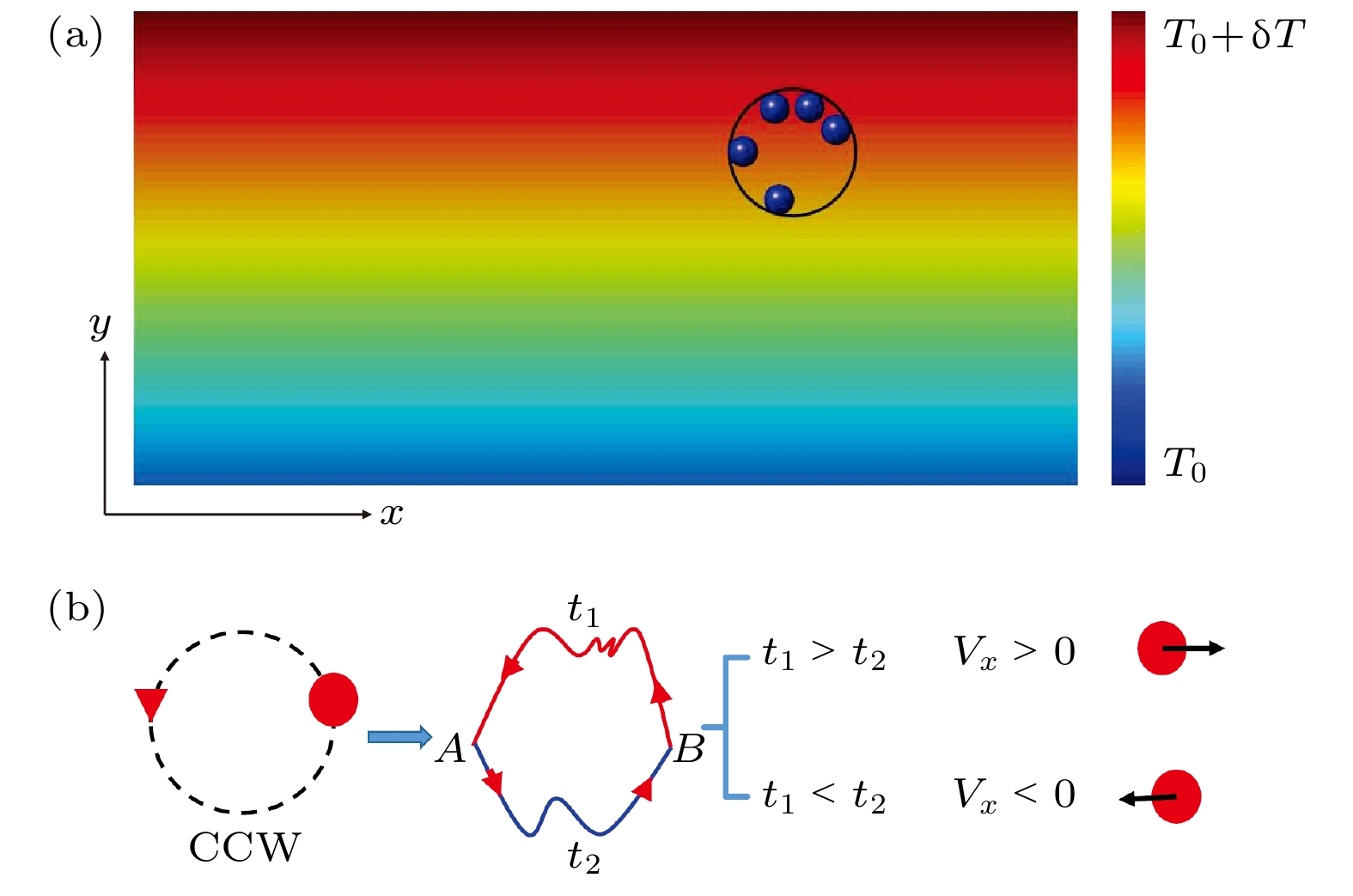















 下载:
下载:

































